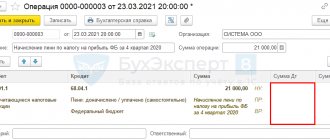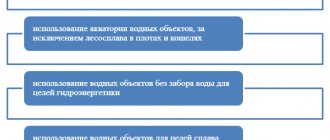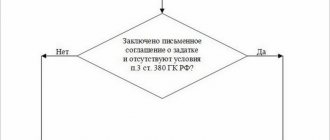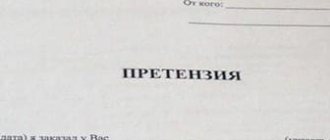Definition of Accounting Entries
An accounting entry is a method of recording business transactions in different accounts. The amounts are equal. Every business entity undergoes several payments and trade transactions every day, including:
- settlements with suppliers;
- payment of taxes;
- transfer of funds for the purchase of devices;
- ensuring the transportation of goods.
Accounting records can also be called a tool for recording income and expenses. Financial activities are reflected using double entry:
- Debit contains information about income from various sources;
- The Credit includes information about expenses, including wages and settlements with counterparties.
Credit and debit accounts are interconnected. They are presented in a single table, which is also known as a correspondent account.
All values in the statements must match the information in the primary documents. In other words, transactions that are reflected in the journals are necessarily confirmed by appropriate documentation.
Return to the full list of SCP opportunities for Kazakhstan
All economic activities of the enterprise are reflected in accounting. The accounting principles implemented in the “Manufacturing Enterprise Management for Kazakhstan” configuration fully comply with Kazakh legislation and at the same time meet the needs of the business.
The composition of accounts, the settings of analytical, currency, and quantitative accounting allow you to take into account the requirements of the law. The user can also independently manage the accounting methodology as part of setting up the accounting policy, create new sub-accounts and sections of analytical accounting. This does not require special knowledge or configuration skills.
Accounting is maintained in accordance with Kazakh legislation for all areas:
- bank and cash transactions;
- fixed assets and intangible assets;
- accounting of materials, goods, products;
- cost accounting and cost calculation;
- currency operations;
- settlements with organizations;
- calculations with accountable persons;
- settlements with personnel regarding wages;
- calculations with the budget.
Accounting automatically reflects all business transactions of the enterprise, registered in other subsystems, and ensures a high degree of formation of financial statements.
Accounting is one of the most critical areas of an enterprise's activities. Accountants must be provided with a reliable and effective automation tool.
The main way to register business transactions in accounting is to enter documents into the information base that correspond to the primary accounting documents. Accounting entries for a document are generated automatically, provided that the document contains the indicator for reflecting the business transaction of the document in accounting. Some documents may not be reflected in accounting.
Direct entry of individual accounting entries is allowed.
Supports accounting for several legal entities in a single information database. This will be convenient in a situation where the economic activities of these organizations are closely related to each other: in this case, in current work, you can use common lists of goods, counterparties (business partners), employees, own warehouses, etc., and generate mandatory reporting separately.
Accounting entries
In traditional accounting, entries are used to record business transactions only in the ledger accounts. In the configuration, the posting functions are expanded: posting can be used to reflect business transactions also in analytical accounting. This is achieved by using additional details in posting - subconto.
Subconto is an object of analytical accounting, and the type of subconto is a set of similar objects of analytical accounting from which the object is selected. Types of subcontos, in particular, are lists of the enterprise's counterparties, warehouses, divisions, employees, a list of inventory items, settlement documents with counterparties, etc.
Subconto types are attached to accounting accounts directly in the chart of accounts.
You can attach up to three types of subaccounts to one accounting account.
An accounting entry can contain a large amount of information.
In addition to the debit and credit accounts, a transaction can include up to three debit subaccounts and up to three credit subaccounts. If for any posting account in the chart of accounts the attribute of quantitative accounting and the attribute of currency accounting are indicated, then in addition to the amount in tenge, the posting record can indicate the quantity and amount in foreign currency (by debit and/or by credit).
Thus, posting is a powerful tool for reflecting business transactions simultaneously in synthetic accounting and in several sections of analytical accounting.
But the versatility of this tool does not create additional difficulties for the user, since, as a rule, transactions are generated automatically. Next >>
Posting classification
There are two types of accounting records:
- simple, which reflect two accounts (debit and credit);
- complex - include more than two accounts.
Postings are used depending on the trading operation.
Postings are also divided according to the nature of the information reflected - into real, conditional and clarifying. Real ones are used to reflect business transactions, for example, the calculation and payment of wages. Conditionals arise as a result of accounting methodology. But in reality this operation was not performed. Used to transfer or clarify indicators.
There can be several examples:
- closing the sales account and determining the financial result;
- production costs include management costs. The latter are accounted for in the “General business expenses” account, while no business facts occur.
Clarifying entries involve maintaining corrective records, as well as records for writing off the calculation difference in the production process accounts. They, in turn, are divided into two categories:
- additional ones, which increase the amount of turnover on the account; regular ink is used when drawing up;
- reversal – when calculating the totals, the red amount is subtracted and drawn up in red ink.
Features of making entries in accounting
Let us determine the key features of drawing up entries for the establishment of the budgetary sector:
- Methods for reflecting business transactions in accounting must be enshrined in the accounting policies of the organization.
- All entries must be reflected in accounting exclusively in rubles, that is, in the currency of the Russian Federation.
- Accounting entries are subject to registration in some primary documents, and then reflected in accounting registers: special journals or orders.
- When reflecting records, it is necessary to maintain chronological order.
- If errors and inaccuracies are detected in accounting records, it is necessary to make corrective entries in accordance with the established procedure.
Let’s make a reservation right away that the organization itself is obliged to approve the working plan of accounting accounts. That is, list those accounts and subaccounts that the company will directly use in accounting. When compiling accounting entries, the table can contain all accounts according to instructions, or only specific values.
Examples of accounting entries
An example of correspondence between two accounts: wages were paid to employees from the cash register in the amount of 500,000 rubles. The operation is reflected by the following posting: On the debit of the account - 70 “Settlements with personnel for wages”, on the Credit - 50 “Cash” - 500,000 rubles.
If transactions affect more than two offsetting accounts, they can be presented in two ways. One account can be debited and several accounts credited. In this case, the total amount credited does not differ from the amount of the debited account.
Example:
The company's account was credited with revenue in the amount of 100 thousand rubles and the amount from the sale of equipment - 50 thousand rubles:
Debit of account 51 “Current accounts” - 150 thousand rubles;
Credit to account 90 “Sales” - 100 thousand rubles;
Credit to account 91 “Other income and expenses”, in this case the subaccount “Other income” is used - 50 thousand rubles.
Complex wiring can be presented in the form of two simple ones:
For debit - 51 “Current accounts”, for Credit - 90 “Sales” - 100 thousand rubles;
Debit 51 “Settlement accounts” Credit 91 “Other income and expenses (subaccount “Other income”)” - in the amount of 50 thousand rubles.
Let's consider another option, when several accounts are debited and one is credited at the same time. In this case, the debit amount is equal to the credit amount.
As an example:
Materials were received from the counterparty in the amount of 50 thousand rubles, as well as equipment for installation in the amount of 50 thousand rubles. A complex accounting entry is reflected as follows:
Debit account 10 “Materials” - 10 thousand rubles;
Debit of account 07 “Equipment for installation” - 50 thousand rubles;
Credit to account 60 “Settlements with suppliers and contractors” - 60 thousand rubles.
Complex wiring can also be presented in the form of two simple ones:
For Debit - 10 “Materials”, for Credit account 60 “Settlements with suppliers and contractors” - 10 thousand rubles;
Debit account 07 “Equipment for installation” Credit account 60 “Settlements with suppliers and contractors” - 50 thousand rubles.
Complex postings significantly reduce the number of accounts, and this allows you to reduce the time for performing analytical and accounting functions.
Compiling correspondence: a cheat sheet for state employees
| By fixed assets | “Which accounting records should state employees use for accounting of fixed assets” |
| “How to keep accounting for depreciation charges: calculations and accounting entries” | |
| “How to write off fixed assets of a budget institution” | |
| “We understand the features of accounting and taxation when selling fixed assets” | |
| Settlements with suppliers and contractors | “How to keep records of settlements with suppliers and contractors” |
| “How to reflect a penalty in accounting: correspondence and rules” | |
| “How to reflect bank guarantees in accounting” | |
| Salary and benefits | “Which accounting entries to use to reflect payroll transactions” |
| “How to keep track of your deposited salary” | |
| “Which accounting entries to use to account for benefits” | |
| Cashless payments | “How to record current account transactions” |
| Cash discipline | "How to keep track of cash" |
| “Check yourself: the procedure for conducting cash transactions” | |
| Settlements with accountants | “How to keep records of settlements with accountable persons” |
| “How to withhold an accountable amount from your salary” | |
| “We process the return of accountable amounts” | |
| “How to keep track of travel expenses in a budget organization” |
Who keeps the accounting records?
Accounting records are required to be used by all business entities - both large companies and individual entrepreneurs using a simplified taxation system. Some organizations are subject to annual audits, so it is very important for them to keep their accounting records in order. These include the following categories:
- joint stock communities;
- insurance companies;
- financial and credit groups;
- securities companies;
- non-state pension funds.
Who is responsible for mistakes
Serious recordkeeping violations may result in the following sanctions:
- tax;
- administrative;
- payment of fines.
Responsibility for errors lies with the chief accountant, as well as the head of the company. If an error is identified in the papers, it is necessary to correct them immediately, as the sanctions can be serious.
The chief accountant is responsible for the damage caused to the direct employer. He acts as a financially responsible person. The procedure for its collection is specified in the employment contract with the employee.
If this information is not reflected in the contract, only penalties can be applied to the accountant, the amount of which does not exceed his monthly salary.
Financial liability is regulated by federal laws and the labor code. An employment contract cannot contradict the laws. It is prohibited to collect an amount greater than that specified in the code.
The manager is also the financially responsible person. All damages that may be recovered from him are indicated in the Labor Code (Article 277). Similar conditions apply to the probationary period.
Every day, companies conduct several transactions. Significant transactions also include transfers between accounts, so all actions must be reflected in the computer database. Some organizations continue to keep records in paper journals.
Postings make it possible to track how, what and in what amount were transferred between correspondent accounts. Using this information, you can get an idea of income and expenses, as well as the company's activities as a whole. Some enterprises carry out mandatory audits of their accounting records. It is necessary to make sure that all postings do not diverge from the primary documentation. This will avoid the application of sanctions.
1C: Accounting 8
“1C: Accounting 8” is the most popular accounting program that can take accounting automation to a whole new level. A convenient product and services connected to it will allow you to effectively solve the problems of the accounting department of any business!
- Support of different tax systems, maintaining accounting and tax records, submitting reports;
- Inventory accounting, batch accounting, settlements with counterparties, extracting primary documents;
- Payroll calculation, accounting of cash transactions;
- Integration with other 1C programs and websites;
- Working with electronic certificates of incapacity for work (ELS).
Try 30 days free Order
Did you like the article?
Want to receive articles like this every Thursday? Keep abreast of changes in legislation? Subscribe to our newsletter






